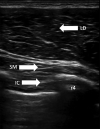Practical Review of Abdominal and Breast Regional Analgesia for Plastic Surgeons: Evidence and Techniques
- PMID: 33425573
- PMCID: PMC7787285
- DOI: 10.1097/GOX.0000000000003224
Practical Review of Abdominal and Breast Regional Analgesia for Plastic Surgeons: Evidence and Techniques
Abstract
Regional analgesia has been increasing in popularity due to its opioid- sparing analgesic effects and utility in multimodal analgesia strategies. Several regional techniques have been used in plastic surgery; however, there is a lack of consensus on the indications and the comparative efficacy of these blocks. The goal of this review is to provide evidence-based recommendations on the most relevant types of interfascial plane blocks for abdominal and breast surgery. A systematic search of the PUBMED, EMBASE, and Cochrane databases was performed to identify the evidence associated with the different interfascial plane blocks used in plastic surgery. The search included all studies from inception to March 2020. A total of 126 studies were included and used in the synthesis of the information presented in this review. There is strong evidence for using the transversus abdominis plane blocks in both abdominoplasties as well as abdominally-based microvascular breast reconstruction as evidenced by a significant reduction in post-operative pain and opioid consumption. Pectoralis (I and II), serratus anterior, and erector spinae plane blocks all provide good pain control in breast surgeries. Finally, the serratus anterior plane block can be used as primary block or an adjunct to the pectoralis blocks for a wider analgesia coverage of the breast. All the reviewed blocks are safe and easy to administer. Interfascial plane blocks are effective and safe modalities used to reduce pain and opioid consumption after abdominal and breast plastic surgery.
Copyright © 2020 The Authors. Published by Wolters Kluwer Health, Inc. on behalf of The American Society of Plastic Surgeons.
Conflict of interest statement
Figures




Similar articles
-
Efficacy of erector spinae plane block for analgesia in breast surgery: a systematic review and meta-analysis.Anaesthesia. 2021 Mar;76(3):404-413. doi: 10.1111/anae.15164. Epub 2020 Jul 1. Anaesthesia. 2021. PMID: 32609389
-
Truncal regional nerve blocks in clinical anesthesia practice.Best Pract Res Clin Anaesthesiol. 2019 Dec;33(4):559-571. doi: 10.1016/j.bpa.2019.07.013. Epub 2019 Jul 19. Best Pract Res Clin Anaesthesiol. 2019. PMID: 31791571 Review.
-
Interfascial Plane Blocks and Laparoscopic Abdominal Surgery: A Narrative Review.Local Reg Anesth. 2020 Oct 23;13:159-169. doi: 10.2147/LRA.S272694. eCollection 2020. Local Reg Anesth. 2020. PMID: 33122942 Free PMC article. Review.
-
Chest Wall and Abdominal Blocks for Thoracic and Abdominal Surgeries: A Review.Curr Pain Headache Rep. 2023 Oct;27(10):587-600. doi: 10.1007/s11916-023-01158-7. Epub 2023 Aug 25. Curr Pain Headache Rep. 2023. PMID: 37624474 Review.
-
Newer regional analgesia interventions (fascial plane blocks) for breast surgeries: Review of literature.Indian J Anaesth. 2018 Apr;62(4):254-262. doi: 10.4103/ija.IJA_46_18. Indian J Anaesth. 2018. PMID: 29720750 Free PMC article. Review.
Cited by
-
The Utility of Erector Spinae Plane Blocks in Breast Surgery: A Practical Review.Plast Reconstr Surg Glob Open. 2025 Apr 2;13(4):e6667. doi: 10.1097/GOX.0000000000006667. eCollection 2025 Apr. Plast Reconstr Surg Glob Open. 2025. PMID: 40182301 Free PMC article. Review.
-
Office-based Plastic Surgery-Evidence-based Clinical and Administrative Guidelines.Plast Reconstr Surg Glob Open. 2022 Nov 9;10(11):e4634. doi: 10.1097/GOX.0000000000004634. eCollection 2022 Nov. Plast Reconstr Surg Glob Open. 2022. PMID: 36381487 Free PMC article. Review.
-
Safe Reproducible Breast Reduction.Plast Reconstr Surg Glob Open. 2023 Sep 22;11(9):e5245. doi: 10.1097/GOX.0000000000005245. eCollection 2023 Sep. Plast Reconstr Surg Glob Open. 2023. PMID: 38152713 Free PMC article. Review.
-
Liposomal Bupivacaine Analgesia in Deep Inferior Epigastric Perforator Flap Breast Reconstruction: A Retrospective Cohort Study.Plast Reconstr Surg Glob Open. 2024 Jun 7;12(6):e5874. doi: 10.1097/GOX.0000000000005874. eCollection 2024 Jun. Plast Reconstr Surg Glob Open. 2024. PMID: 38855138 Free PMC article.
-
Trends and Innovations in Autologous Breast Reconstruction.Arch Plast Surg. 2023 May 29;50(3):240-247. doi: 10.1055/s-0043-1767788. eCollection 2023 May. Arch Plast Surg. 2023. PMID: 37256033 Free PMC article.
References
-
- Alexander JC, Patel B, Joshi GP. Perioperative use of opioids: current controversies and concerns. Best Pract Res Clin Anaesthesiol. 2019;33:341–351. - PubMed
-
- Joshi GP, Kehlet H. Postoperative pain management in the era of ERAS: an overview. Best Pract Res Clin Anaesthesiol. 2019;33:259–267. - PubMed
-
- Jogerst K, Pockaj B. ASO author reflections: enhanced recovery after surgery (ERAS) principles extend beyond abdominal surgery. Ann Surg Oncol. 2020;27:3446–3447. - PubMed
-
- Joshi GP, Kehlet H. Enhanced recovery pathways: looking into the future. Anesth Analg. 2019;128:5–7. - PubMed
Publication types
LinkOut - more resources
Full Text Sources
Other Literature Sources
